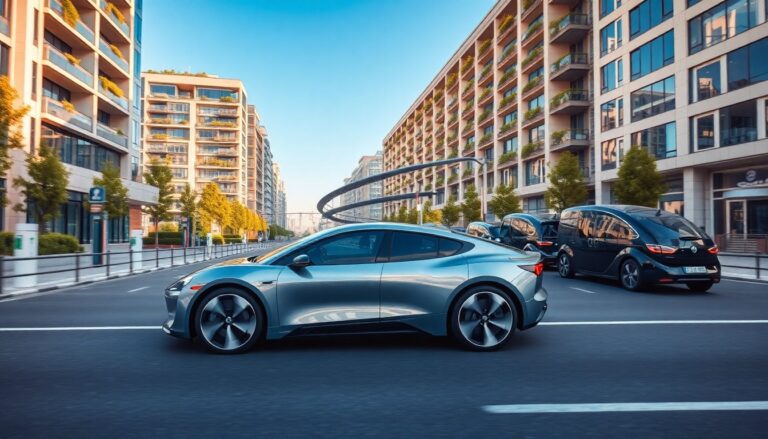Argomenti trattati
The automotive industry is experiencing a transformative shift as it adopts new technologies and innovations poised to redefine transportation. The rise of electric vehicles (EVs), autonomous driving, and advanced connectivity features highlights a future that is both promising and complex. This article delves into the key trends influencing the automotive landscape, offering insights into how these developments will affect both consumers and manufacturers.
The electric vehicle revolution
As climate change and fossil fuel depletion become pressing issues, the transition to electric vehicles is essential. EVs generate zero emissions during operation, positioning them as a viable alternative to traditional internal combustion engine vehicles. Industry experts confirm that major automakers are heavily investing in battery technology and infrastructure to facilitate this shift.
The evolution of battery technology
One of the primary obstacles to the widespread adoption of electric vehicles (EVs) is the quest for efficient and affordable batteries. Recent advancements in lithium-ion batteries have significantly enhanced energy density and reduced charging times. Industry experts confirm that companies are also investigating alternative battery technologies, particularly solid-state batteries, which offer the potential for even greater efficiency and safety. As these innovations progress, consumers can anticipate a broader selection of affordable electric vehicles becoming available in the marketplace.
Expanding charging infrastructure
The growth of the electric vehicle (EV) market relies heavily on a well-developed charging infrastructure. Industry experts confirm that governments and private companies are working together to enhance charging networks. This collaboration is vital for facilitating the transition to electric vehicles. Fast-charging stations are increasingly becoming available along highways and in urban centers, significantly cutting down the time required to recharge an EV. Such advancements are essential for addressing range anxiety, a prevalent concern among potential EV buyers.
The evolution of autonomous driving
Autonomous driving technology has emerged as a focal point for innovation, attracting interest from various sectors. Industry experts confirm that the race to develop fully self-driving vehicles is intensifying. The advantages of autonomous vehicles are compelling: they promise to enhance safety on the roads, alleviate traffic congestion, and provide greater mobility for individuals who cannot drive. However, the journey to achieving fully autonomous driving is fraught with significant technical and regulatory hurdles that must be navigated.
The evolving landscape of safety and technology
Advancements in driver-assistance systems, including lane-keeping assist and adaptive cruise control, are setting the stage for enhanced autonomous features. These innovative systems leverage a combination of radar, cameras, and machine learning algorithms to analyze the vehicle’s environment and make instantaneous decisions. However, the paramount concern remains the safety and reliability of these technologies. Extensive testing and validation are essential to ensure that full automation can be safely achieved without compromising driver security.
The journey toward autonomous vehicles is significantly impacted by regulatory challenges. Policymakers face the task of creating comprehensive frameworks to govern the testing and deployment of self-driving technology. Key considerations include liability issues in case of accidents, data privacy, and the necessity for updated traffic laws. As the technology advances, regulations must evolve to ensure safety and accountability.
The rise of connectivity and smart features
The automotive industry is undergoing a transformation with the integration of connectivity features in vehicles. Modern automobiles are increasingly adopting Internet of Things (IoT) technology, facilitating real-time data exchange between vehicles and external networks. This connectivity enhances safety measures and significantly improves the overall driving experience for enthusiasts and everyday drivers alike.
Understanding vehicle-to-everything (V2X) communication
Vehicle-to-everything (V2X) communication technology is revolutionizing how vehicles interact with each other and their surroundings. This technology facilitates communication between vehicles and infrastructure, including traffic lights and road signs. By optimizing traffic flow and reducing accidents, V2X enhances navigation systems. As cities evolve into smarter environments, the deployment of V2X technology will be essential in developing safer and more efficient transportation networks.
The evolution of infotainment and user experience
The demand for advanced infotainment systems in vehicles is rapidly increasing. Modern consumers are on the lookout for user-friendly interfaces that combine navigation, entertainment, and connectivity features. In response, manufacturers are integrating smartphones and other devices into the driving experience. This ensures drivers can stay connected without compromising safety, reflecting a growing emphasis on user experience in the automotive sector.
The future of automotive technology heralds significant advancements in electric vehicles, autonomous driving, and connectivity. These innovations are set to foster a more sustainable, efficient, and enjoyable driving experience. Industry experts confirm that achieving this future will necessitate collaboration among manufacturers, governments, and consumers. Together, they must navigate the challenges that arise in this evolving landscape.

